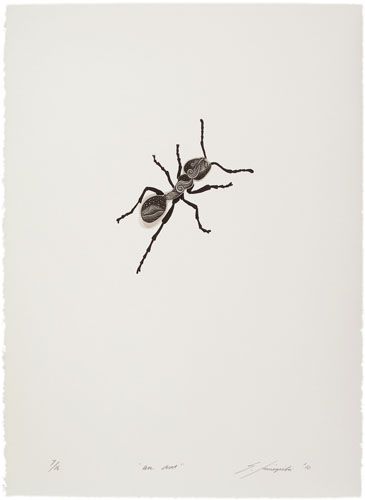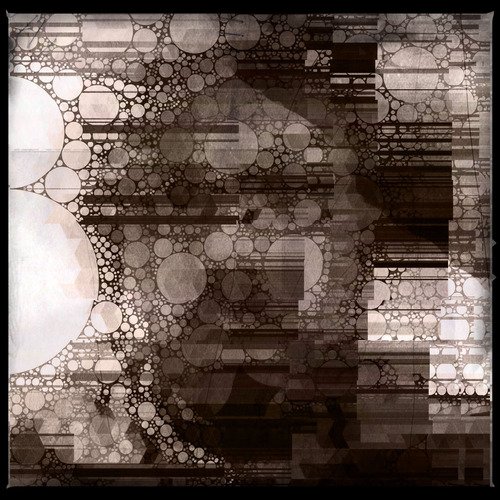To Kill an Ant :: Haiku of Japan #65
【Update 2023-11-7: This is an outdated version of this article. For a more up to date version, please see: https://laspina.org/to-kill-an-ant/ 】
蟻殺すわれを三人の子に見られぬ
ari korosu ware o sannin no ko ni mirarenu
I killed an ant...
then realized
my three kids were watching
—Shūson
(trans. David LaSpina)

("An Ant", by Shinsuke Minegishi)
Shūson was one of the more famous modern haiku poets. Initially he hated the restrictive format of haiku and preferred the 31-morea† tanka. Then he met Shūōshi Mizuhara, a highly acclaimed haiku poet, and fell in love with the small verse. He had a serious illness in the 1960s and once recovered from it, his haiku took on ideas of human life and life in general.
His mentor, Mizuhara, was one of the free style haiku poets of whom I've talked of before. We can see that influence in this haiku, which by my count is 5/8/6 instead of the standard 5/7/5 count.
This may be one of Shūson's most famous verses. It illustrates a tricky situation that I'm sure all parents have found themselves in at least once, the moment when we are caught doing something we tell them not to do.
I can especially relate. I always teach my boys to not kill and be kind to insects and animals. If we find spiders or even cockroaches in the house, I always get my boys to help me trap them, then we let them go outside. Yet a summer or two ago I was being bothered by mosquitoes at my in-law's house and I impulsively smashed one that was biting my leg. Suddenly I heard a small voice cry: "Papa, why did you kill that bug?! That was a bad thing to do!"
How do you respond to something like that?
Footnotes:
†: Syllables. See: Does Haiku Have to be 17 Syllables
❦
| Don't miss other great haiku in the Haiku of Japan series! |
|---|
#1–10 — Haiku of Japan :: Collection #1
#11–20 — Haiku of Japan :: Collection #2
#21–30 — Haiku of Japan :: Collection #3
#31—40 — Haiku of Japan :: Collection #4
#41–50 — Haiku of Japan :: Collection #5
#51 — Dewdrop World
#52 — A Fleeting Life
#53 — The Only Sound
#54 — Autumn Clouds
#55 — Playing Dewdrops
#56 — To the Last Drop
#57 — A Rest From Moonviewing
#58 — Forever Young
#59 — Fading into the Mist
#60 — Wiping Horse Poop
#61 — Turncoat Umbrella
#62 — Ten Autumns
#63 — Scattering Leaves
#64 — Gravekeeper
 | David LaSpina is a translator and photographer lost in Japan, trying to capture the beauty of this country one photo at a time. and searching for the perfect haiku. He blogs at https://laspina.org/ |
Three cheers for your papa-ethics! Pulling apart the Kanji for "ant" (ouch, not a good way to put it! especially not since the compound character even looks a bit like an ant somehow), but I stumbled across an obsolete pronounciation of ari-no-ko and wondered if to the well versed Haiku ear this askance reference would have added a layer (with the silent repeat "no ko" in "my children"); would this implied correspondence emphasise the imagery of life=life in ants as in kids? Or am I seeing things a Japanese reader could not possibly hear?
I don't know of that reading—it's not in my dictionary. Few Japanese would be silently thinking that. The truth is, few Japanese understand haiku at all. They have the same problem we do, they don't understand the allusions or any of the subtle wordplay. Reading old haiku for today's Japanese is like reading Shakespeare is for English speakers: we understand the words (sometimes), but the broader meaning is often beyond us without a teacher to explain it.
Thank you so much for your thoughts on this, it helps me think on further about meaning and knowing v feeling our way through it.
Resteemed your article. This article was resteemed because you are part of the New Steemians project. You can learn more about it here: https://steemit.com/introduceyourself/@gaman/new-steemians-project-launch